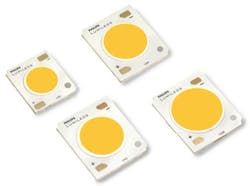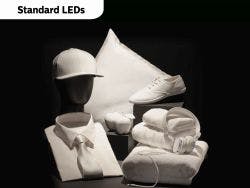A mix of LEDs at different levels of blue underlies chip-on-board devices that makes white appear crisp while also rendering vivid saturated colors for applications such as retail.
Philips Lumileds has formally announced the CrispWhite family of chip-on-board (COB) LEDs after displaying products that use the source at two recent trade fairs. The LED platform is designed specifically to replace ceramic-metal-halide (CMH) lamps in retail solid-state lighting (SSL) applications. Lumileds says the LED closely mimics the spectral power distribution of a CMH lamp and delivers the combination of vivid saturated color rendering and daylight-like whites.
Philips has alluded to the capabilities of the CrispWhite LED at both Light+Building and LightFair International (LFI), saying the COB delivered a mix of 3000K and 4000K CCT light for optimal color and white performance. Indeed, Philips and Amerlux demonstrated lighting products that integrated the LEDs at LFI. But the story behind the CrispWhite LEDs is a bit more complex than the company's LFI press release would indicate.
Brightening agents
Lumileds designed the COB LED to render whites crisply, especially in the presence of optical or fluorescent brightening agents (OBAs) that are regularly applied to white paper and fabrics. A recent feature article written by Soraa covered the color science behind such agents that make whites look crisp in daylight and under certain artificial lighting, including CMH sources. Soraa has touted the violet emitter used in its LEDs as capable of exciting the brightening elements and delivering the perfect white appearance of treated paper and fabrics.
To excite OBA elements, Lumileds is mixing its standard blue-pump LED chips with what it calls some deep-blue chips in the CrispWhite COB products. If you look at the spectral power distribution of a typical LED, you will typically see an energy peak in the blue region that is attributable to the blue pump with the broader energy distribution at longer green, yellow, and red wavelengths attributable to phosphor. The CrispWhite LEDs have a second blue peak in the 410-nm region to deliver the short-wavelength light that makes OBA whites look best.
Lumileds claims that its approach is superior to the violet emitter used by Soraa for a couple of reasons. Eric Senders, global marketing director at Lumileds, said the violet emitter approach yields an efficacy penalty relative to the mix of standard- and deep-blue emitters used in CrispWhite. Moreover, he said there are photobiological safety issues with violet wavelengths that don’t exist in the deep-blue region.
The efficacy advantage is clear in the specifications. The CrispWhite LEDs deliver 90 lm/W across a product family that spans from 9- to 19-mm light emitting surfaces (LES). Soraa doesn't regularly publish efficacy values for its LEDs but in the aforementioned articled pegged it at 80 lm/W.
White point target
Still, the CrispWhite platform differs from other typical high-CRI LEDs and legacy sources in more ways that are also significant, according to Lumileds, in the hospitality application. The white point of the LEDs is targeted via the phosphor formulation below the black-body curve. That is a trick that Luminus Devices demonstrated at LFI and that is detailed in the above link on LEDs at the exhibition.
Senders points out that the white point of the CrispWhite LEDs both matches the legacy performance of CMH lamps (Philips refers to them as CDM or ceramic discharge metal halide) and also lines up with consumer preference documented by the Lighting Research Center (LRC) at Rensselaer Polytechnic Institute. We covered that research in an article on the 2012 Strategies in Light conference in which the LRC tested white point in a retail-like mock environment.
CRI and R9
Lumileds also compared the CrispWhite LED with other high-CRI LEDs and light sources. The new LED delivers a CRI of 91 but only an R9 value for saturated reds of 55. The relatively-low R9 value may be in part the reason that the CrispWhite LEDs come in only 1–2% lower than Lumileds standard high-CRI COBs in efficacy. But Senders said the lower R9 value translates to the expected and desired performance in the retail application.
Senders said sources with a high R9 value in the 90 range can result in white or light colors that have a slight reddish to yellowish appearance. Typical CMH lamps used in retail have an R9 value in the range of 39, and have been the gold standard for the retail industry, according to Senders.
Lumileds is also only offering the LEDs within a three-step MacAdam ellipse in terms of color consistency. Many COB makers offer two-step bins. But Senders said the LRC research proves that for white points below the black-body curve, humans can't perceive a three-step difference whereas such a difference is far more noticeable above the black-body curve.
The CrispWhite family is aligned precisely with Lumileds' existing COB LEDs in terms of LES, lumen output, and driver capabilities. Lamp or luminaire manufacturers will be able to use the same design with either a standard COB or one of the CrispWhite models. At typical drive current the maximum lumen package is 3750 lm, but Senders said you can overdrive the LEDs to reach 6000 lm at only a slight efficacy penalty. He said that performance level will allow the CrispWhite family as launched to supplant CMH sources up to the 100W level.








